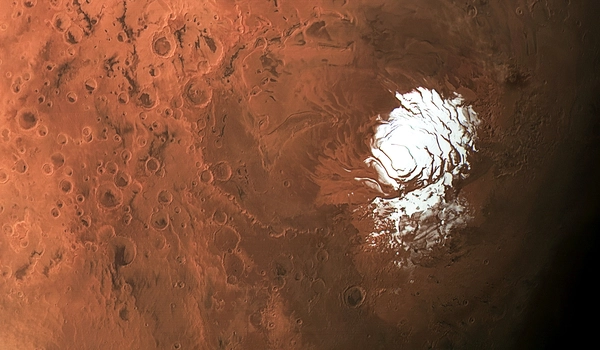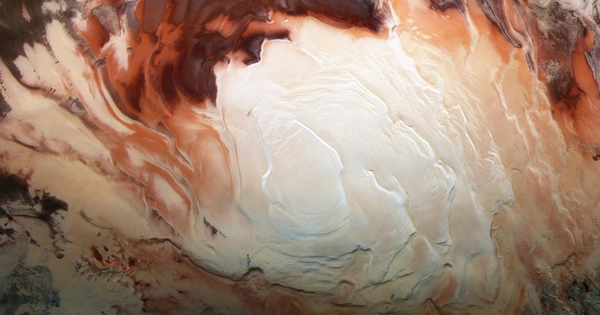Scientists measured the properties of ice-brine mixtures at temperatures as low as -145 degrees Fahrenheit to help confirm that salty water exists between grains of ice or sediment beneath Mars’ south pole ice cap. Laboratory measurements back up unusually bright reflections detected by the MARSIS subsurface sounding radar aboard the European Space Agency’s Mars Express orbiter.
A scientist from the Southwest Research Institute measured the properties of ice-brine mixtures as cold as -145 degrees Fahrenheit to help confirm that salty water exists between grains of ice or sediment beneath Mars’ south pole ice cap. SwRI geophysicist Dr. David Stillman’s laboratory measurements back up unusually bright reflections detected by the MARSIS subsurface sounding radar aboard ESA’s Mars Express orbiter.
According to Martin Siegert, a geophysicist at Imperial College London who leads a consortium attempting to drill into Lake Ellsworth under West Antarctica, the lake resembles one of the interconnected pools that sit beneath several kilometers of ice in Greenland and Antarctica. However, the processes that gave rise to a deep lake on Mars are most likely different. “It will open up a very interesting scientific area on Mars,” he says.
Lakes of liquid water exist beneath glaciers in the Arctic and Antarctic regions, so we have Earth analogs for finding liquid water beneath ice. Exotic salts known to exist on Mars have incredible ‘antifreeze’ properties, allowing brines to remain liquid down to -103 degrees Fahrenheit.
Stillman
MARSIS flies over the planet with a 130-foot antenna, bouncing radio waves over a specific area and then receiving and analyzing the echoes or reflections. Any near-surface liquid water should emit a strong, bright signal, whereas ice and rock would emit a much weaker signal.
Because conventional models assume the Mars south polar cap experiences temperatures much lower than the melting point of water, many scientists have questioned the presence of liquid water. Clay, hydrated salts and saline ices have been proposed as potential explanations for the source of the bright basal reflections. The Italian-led team investigating the proposed phenomena used previously published data, simulations and new laboratory measurements.
Water is thought to have flowed across the surface of Mars billions of years ago, when its atmosphere was thicker and warmer, carving gullies and channels that are still visible. However, today’s low atmospheric pressures mean that any surface water would boil away. Water survives frozen in polar ice caps and subsurface ice deposits. Some deposits have been mapped by the Mars Advanced Radar for Subsurface and Ionospheric Sounding (MARSIS), an instrument on the European Space Agency’s Mars Express orbiter, which launched in 2003. MARSIS sends out radio wave pulses and listens for reflections. Some of the waves bounce off the surface, but others penetrate up to 3 kilometers and can be reflected by sharp transitions in the buried layers, such as going from ice to rock.

“Lakes of liquid water exist beneath glaciers in the Arctic and Antarctic regions, so we have Earth analogs for finding liquid water beneath ice,” said Stillman, a specialist in detecting water in any form — liquid, ice, or absorbed — on planetary bodies and co-author of a paper describing these findings. “Exotic salts known to exist on Mars have incredible ‘antifreeze’ properties, allowing brines to remain liquid down to -103 degrees Fahrenheit. In our lab, we studied these salts to see how they would react to radar.”
Stillman has over a decade of experience measuring the properties of materials at cold temperatures to detect and characterize subsurface ice, unfrozen water, and the potential for life throughout the solar system. For this project, Stillman measured the properties of perchlorate brines in a SwRI environmental chamber that produces near-liquid-nitrogen temperatures at Mars-like pressures.
“My Italian colleagues contacted me to see if the data from my laboratory experiment would support the presence of liquid water beneath the Martian ice cap,” Stillman explained. “The study demonstrated that we do not need lakes of perchlorate and chloride brines, but that these brines can exist between the grains of ice or sediments and exhibit a strong dielectric response. This is similar to how seawater saturates grains of sand on the beach or flavoring permeates a slushie, but at -103 degrees Fahrenheit beneath a mile of ice near Mars’ South Pole.”
Because all known life requires water, the search for water in the cosmos is rooted in the search for potential habitability. “In this case, ‘following the water’ has led us to a place where life as we know it cannot flourish,” Stillman explained. “However, it’s still fascinating, and who knows what evolutionary paths extraterrestrial life might have taken?”
















